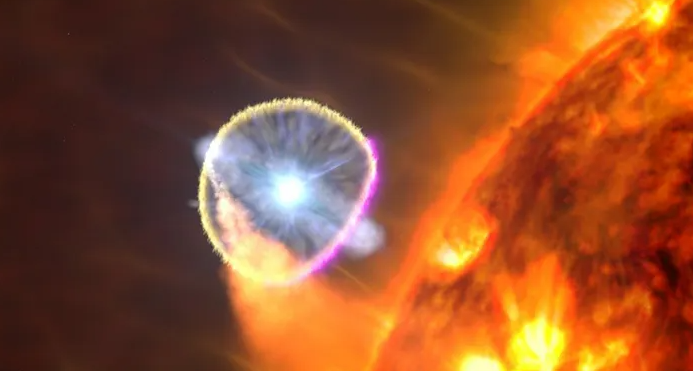NASA predicts that the recurrent nova T Coronae Borealis will explode sometime in 2024 in a rare event that could be visible to the naked eye.
The star system is located 3,000 light years from Earth.
“Unfortunately, we don’t know the timing of this as well as we know the eclipse,” NASA Meteoroid Environment Office lead Bill Cooke said.
“But when it happens, it’ll be something you’ll remember.”
“A typical nova consists of a star, like a red giant — a star bigger than the sun — and a white dwarf, which is a star about the size of the Earth,” Cooke said.
“And that red giant is dumping material on the surface of that white dwarf. They’re orbiting each other, and they’re real close together,” he said.
“When that happens, that white dwarf blows all that material out in space, and it gets very bright, hundreds of times brighter than what it was before,” Cooke said.
“And if it’s close to us or relatively close to us, we will see a new start to appear in our sky.”
T Coronae Borealis undergoes a nova explosion approximately every 79 years as material from a red giant star is dumped onto the surface of an orbiting white dwarf, causing a thermonuclear reaction that blows the material out in a bright flare.
“T Coronae Borealis is unusual in that it doesn’t blow its stack once,” Cooke said. “It does it every 79 years or so.”
The last recorded explosion was in 1946. When it explodes again, astronomers estimate it will increase in brightness enough to be seen without a telescope for about a week before dimming again.
Viewing the rare stellar explosion is being described as a unique opportunity to witness an astronomical event not often seen.
“At the time that star blew up, 3,000 years ago, the Bronze Age was ending,” Cooke said. “You had the rise of the kingdom of David in Palestine. You had all this stuff going on, but that’s how far back in time that explosion occurred — 3,000 years.”
“But when it blows its stack, it’s going to reach about magnitude +2,” Cooke said.
“So to give you an idea of how bright that is — it’s about as bright as Polaris, the North Star.”
“You [will] see a new star suddenly appear there,” Cooke said.
“It’ll look like it appears out of nowhere, and it’ll stay visible for about a week before it dims back down,” he added.
“It’s kind of like Halley’s Comet, but most people don’t know much about it,” Cooke said. “Halley gets all the press.”
“Is it going to be the star of Bethlehem? No,” Cooke said.
“But there will be a new star appearing in our sky for about a week. And let’s face it, how often do you see a star explode?”
“Bear in mind, you’re only going to have a few days to see it,” Cooke said.
“I’ve been to a few eclipses, and it’s one of nature’s most awesome spectacles,” he said.
“But frankly, there are two solar eclipses a year. And if there’s not one over the U.S., I could travel to Egypt in 2027 to go see one. We don’t see a star explode very often. So that’s its uniqueness.”


































